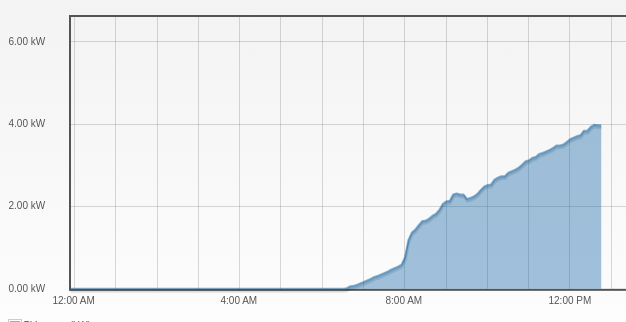For the first day this year, I’ve got absolutely clean production curves for the house array , and thought I’d share. This was a 69-70kWh day, absolutely clear skies, with enough wind to keep the array quite cool in operation.
First, the south array. This is a south facing, 45 degree array, with 6 panels, that produces a very “normal” solar curve - a smooth arc throughout the day. The morning side of the curve tends a bit higher than the evening side, as the panels are colder in the morning. The difference between 0C and 15C on my panels is about 6%, and you can notice it in the curves. Scale here is half the scale for the others, vertically - it peaks around 1.7kW. Production today was 12.29kWh, or 2.04kWh/panel.

Next, my west frame. This frame is the west one, and due to the slope of our hill, is somewhat lower than the east frame, meaning it’s shadowed in the morning as the sun rises. The “chunk” missing out of the left is from shadows, and it produces almost nothing while a strip of shadow climbs down it. I was aware they’d self shade slightly like this, and it doesn’t bother me. You can see the far, far flatter production curve spread across the day. It comes online far earlier and holds a far greater amount of power until the sunset. During the summer months, this should be holding power from 6:30 AM until 9PM. Production today was 28.58kWh, or 1.19kWh/panel.

The east frame is the reverse, being shadowed in the evening. However, being a bit higher, it holds power longer into the evening and has less of a cutoff than the west frame. Moving enough dirt or building the frames higher to make them exactly level didn’t seem worth the effort… Total production today was 29.79kWh, or 1.24kWh per panel.

Summing them all together, this is roughly what my power curves look like. It’s a weird, multi-lobed curve that definitely has some early/late power generation benefits, but the real benefits of the east-west panels are going to be during summer demand - they’ll be generating strongly while the south array is still backlit (I run into this on my south facing office panels for a good chunk of the summer). At the peak of summer, there will be another 2 hours on each side of the curve. You can also see the very real difference in the morning and evening lobes.
I knew the system would still be peaking mid-day like this, and while not as bad as a pure south facing system in terms of “percenage of power generated mid-day,” my original assumption was that the EV charging would be happening mid-day. Before Covid, my wife frequently went into town with the kids for something or other in the morning, coming back around 11 or noon. A few hours of 3.3kW charging mid-day would trim down that fat mid-day peak, better matching grid curves. We just don’t drive much anymore…

Enjoy!


 Would be fun to time you washing off the panels and seeing if there’s a significant, noticeable lift in production. Is a slight film of dust that impactful or not really until it’s a significant amount of coating.
Would be fun to time you washing off the panels and seeing if there’s a significant, noticeable lift in production. Is a slight film of dust that impactful or not really until it’s a significant amount of coating.









